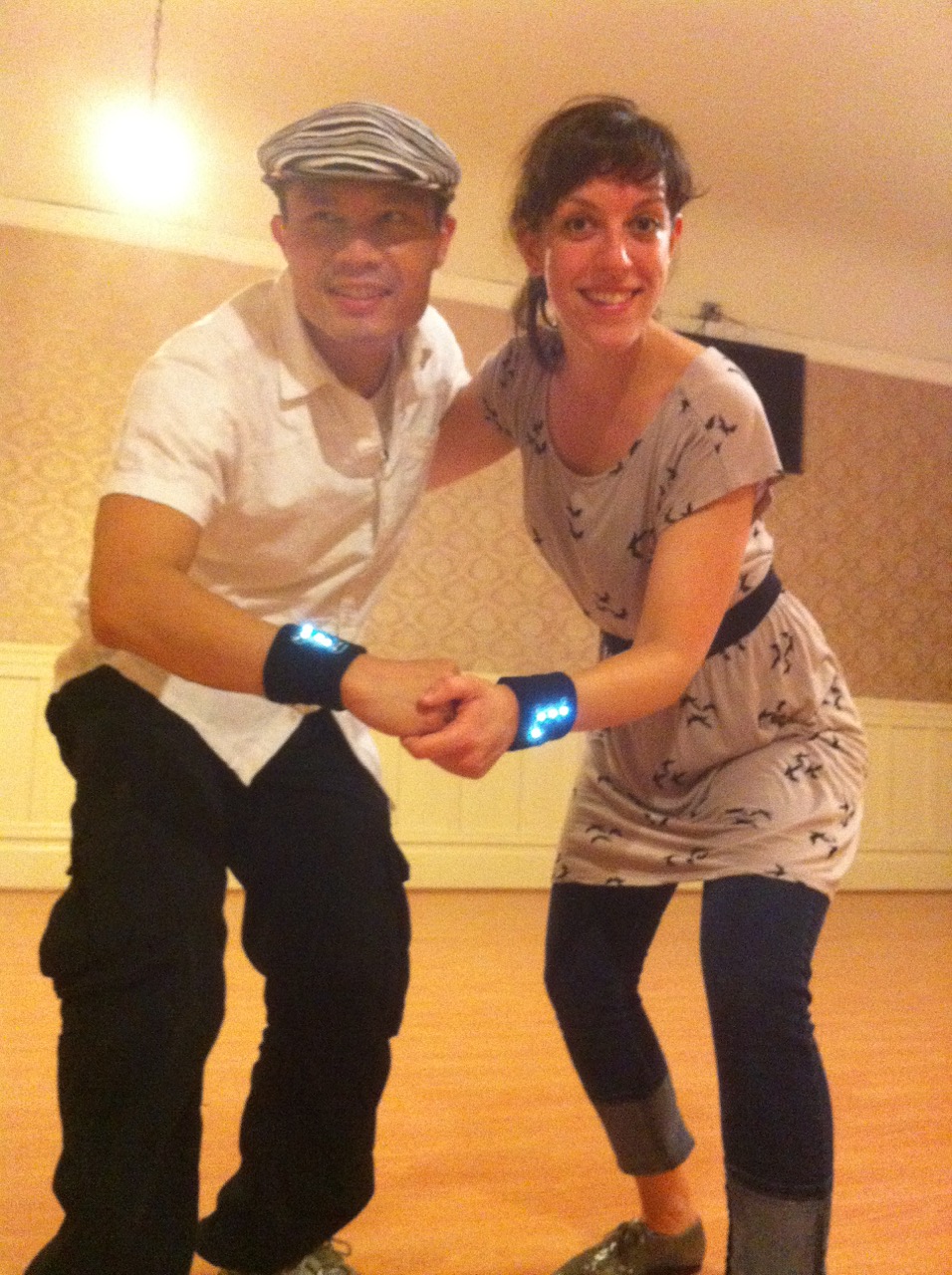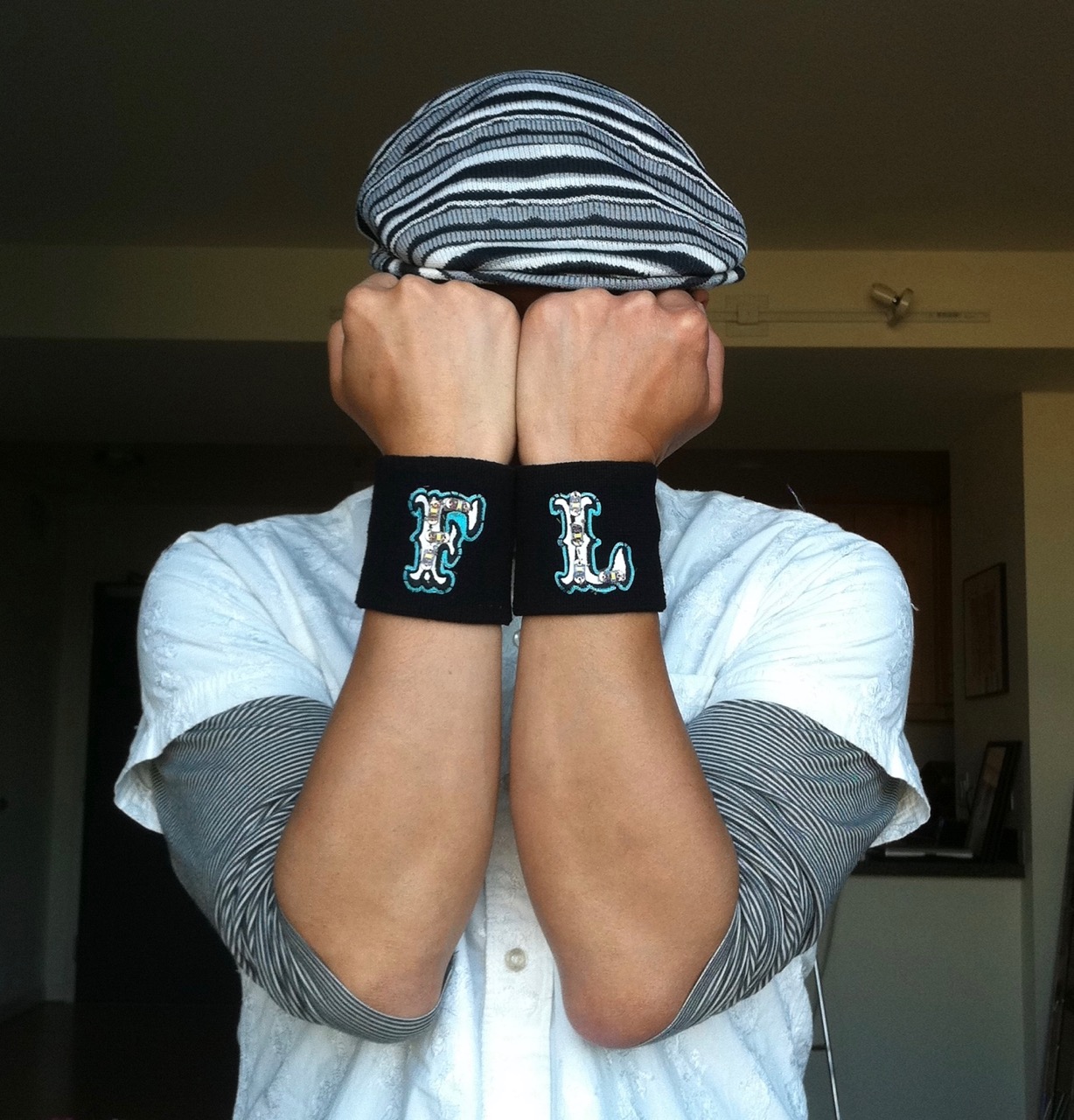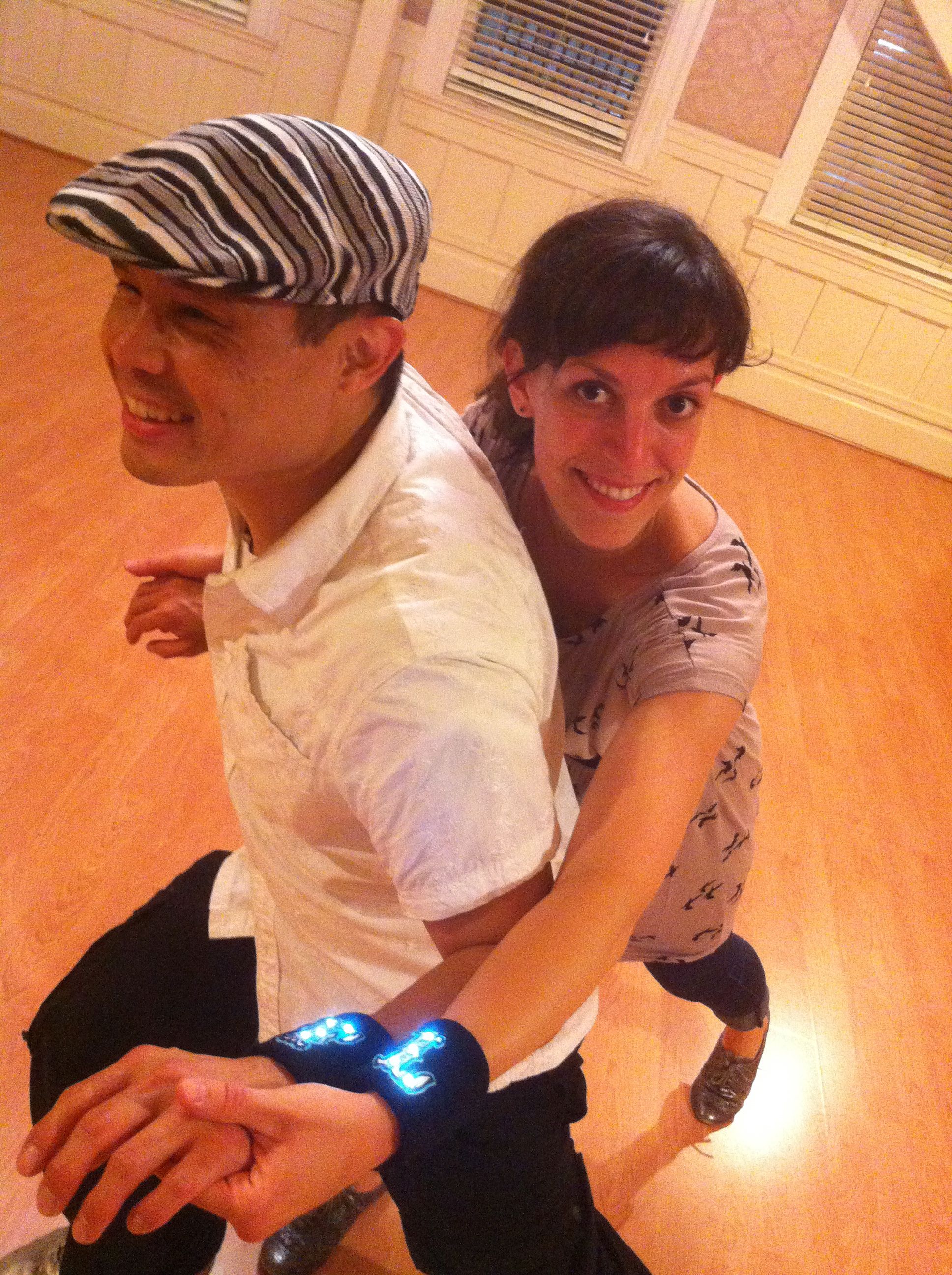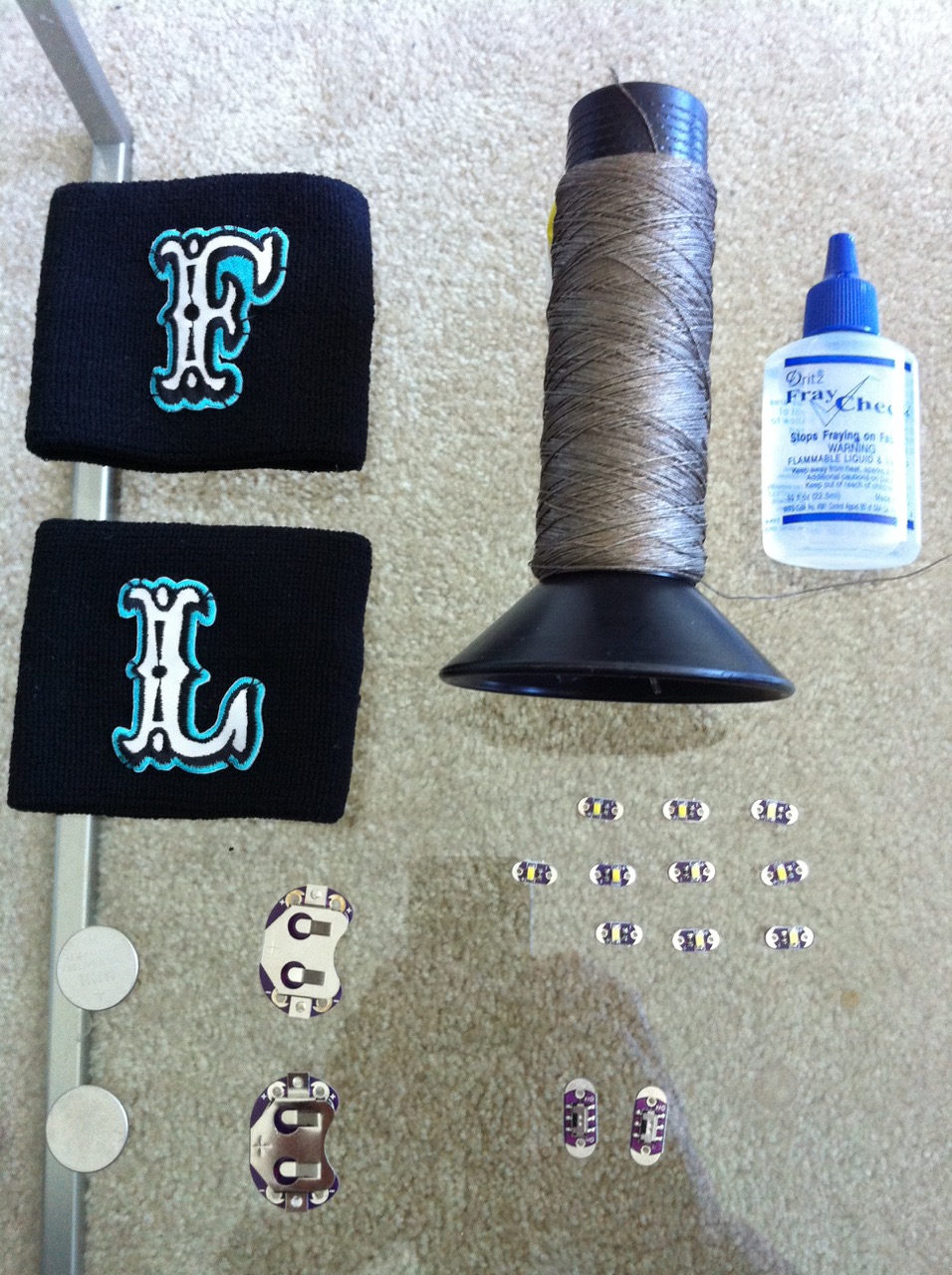For the past couple of years, I have been thinking about how gender roles interact with dance roles in lindy hop (and other social dances.) As someone who cares about this dance and wants it to be an artform that is welcoming and available to everyone, regardless of gender, orientation, identity or preference, the strict division of lindy hop into “men lead” and “women follow” has never sat well with me.
I have been trying to imagine a dance space where gender is not automatically associated with dance role, where a woman could feel free to lead and a man to follow, and that was fully affirmed and accepted. But how would that work? I realized that there is an information problem that must be solved before we can have a more open social dance system. And technology is a tool for addressing information problems.
But first some background on how a typical lindy hop dance works…
How Social Dance Partnerships are Negotiated
You have to have a bit of background in how the lindy hop scene tends to operate to understand the complications. Typically, if you are a lindy hopper, you go to a dance venue (a studio, concert or a club) and scan the room for people to dance with. If you are a man, and you walk into a room and see a room full of women, you can assume that these people are in theory available to you to dance with, since you can assume that all of them are going to want to play the “follower” role in the dance. A woman asking a man to dance will normally make the assumption that he is going to play the “leader” role.
There are of course exceptions and outliers in every scene — that one girl who only likes to lead or that guy who doesn’t mind playing either role. But this knowledge depends on knowing the individuals in the venue. At a typical dance event, it is not required that you have ANY specific information about the other person before approaching them to ask them to dance.
It is the practice of most dances in the United States that people change partners at the end of every song. (In other countries, as I understand it, it is every two songs.) As a song finishes and the next one begins, there is a quick scramble to find a new partner, a process that takes at most a few seconds.
In a scene where all men lead and all women follow, this immediately gives someone wanting to dance important information : who currently is a potential next partner. You can quickly scan a dance floor and see what is the potential population, and then pick someone based on your own criteria (perceived dance ability, attractiveness, whether you have danced with them already that evening, etc.) Indeed, every person in the room is going through that exact process at the same time when a song ends.
You approach the person you have targeted and ask them to dance. Hopefully they say yes. Then the next song begins and dancing ensues.
This system works quite well in general, obviously, or there wouldn’t be thousands of swing dances all over the world, with millions of transactions like this happening every night. But it is a system that implicitly rewards those who adhere to the “men lead / women follow” norm.
Bucking the System
There are of course no laws that prevent anyone from performing any role they wish at a lindy hop dance. No one is going to stop a girl from leading or a guy from following. But it’s the process of how social dances are negotiated that imposes penalties on those who choose to go against the system. In short, it makes it hard for you to get your dance on.
If you are a male who follows, for example, you don’t have the benefit at the end of a song knowing in an instant who is available to you to lead you. Is that man over there willing to lead another man? Is that woman a potential leader? You may have this information at your fingertips, but it takes more work on your part to swiftly negotiate a new partnership during the song transition period. This may lead you to not have a partner for the next song… or the next… or the next. And eventually you may give up entirely and switch to the traditional gender role, or just stop dancing altogether.
This is not a hypothetical. When I was in the earlier years of my dance career, I enjoyed very much following, nearly as much as leading. I was not very good at it, but I enjoyed the challenge and the fresh perspective on the dance. But determining who would lead me during a dance was a huge chore, sometimes getting rejected, or missing that one lead who I like dancing with, or having a terrible dance with someone who apparently did not really want to be leading me.
So I quit following, and soon completely forgot how. And I’ve been leading ever since.
My story is not a unique one, I believe. There are just a handful of lindy hoppers I know who dance against the norm, and they have done so through dogged persistence and stubbornness. It’s my contention that this doesn’t have to be so hard.
Technological Solution?
So assuming that we want to have a dance community where people were more free to play either role in the dance, how can we solve this information / negotiation problem? How can dancers quickly exchange information among each other about their preferred dance role?
Enter the “Wrist Roles.”
The Wrist Roles* are prototype wristbands embedded with LEDS that quickly signal to other dancers your preferred dance role(s). The wristbands I created use clear lettering, bright LEDs, and were made using “soft circuit” conductive thread, a battery holder, and a simple slide switch to turn it off and on.
The “L” Wrist Role is worn on the left hand, because that is typically the hand that a person leads with; and thus the “F” Wrist Role is worn on the right. A person can choose to wear just one or both, depending on what they wish to signal that evening.
The intended use is for an entire room of dancers to all be wearing Wrist Roles. The leaders in the room would alight their “L” Wrist Roles and the followers would alight the “F” ones. Someone walking into the room could quickly ascertain how many leads and follows there were by checking the wristbands, regardless of the gender breakdown. And during the critical “next dance” negotiation phase, each person could quickly see who is available to lead or follow them.
In theory, you could just have people put on colored or glowing wristbands like you used to see at raves as indicators. This would be cheaper to do for an entire venue for sure. My friend Mary Christenson in New Haven tells me that they wear buttons that function essentially the same way.
But I believe the ability to turn the Wrist Roles on and off is an important function. If someone is wearing both bands, and likes to perform both roles in the dance, they could simply alight both of them. Or if in that particular moment, the person feels like following, he can just alight the “F” one. And perhaps if someone were taking a break from dancing, she would turn off both of your Wrist Roles to signal to others that she is “off duty.”
Next Steps
These are obviously just prototypes and could use a lot of improvement. The build quality is not the greatest since my crafting skills are rudimentary. The LEDS, battery holder and switch can easily scratch or get caught in the hair or clothing of your partner. The “sewable circuits” are softer than wire, but not as durable. On the other hand, they ARE washable.
One obvious suggestion from my friend Ann was to have the LEDS on the L and F Wrist Roles come in different colors. Coming up with gender-neutral color schemes is a bit tough. Perhaps green for follows and blue for leaders? Or red and white?
If there was a commonly understood color system, people could just choose to wear on the appropriate wrist anything that glowed in the correct color. A bulky cloth wristband with a giant glowy “F” or “L” certainly is not fashionable for most people, other than geeks like me.
To be clear, the intent of this project is not to try and impose this as some kind of technological fix, but to use this to raise awareness and discussion of what I think is a problem in our scene. I believe if we don’t think strategically and creatively about how to make lindy hop as open and inclusive as possible, we will not see this dance spread as far and wide as we would like, for succeeding generations to enjoy.
So what do you think? What would it take to evolve our scene toward one that truly gave every person an open choice in the role in the dance they wish to play, regardless of gender? Would some signalling system like this help? Could you imagine some kind of system like this reaching broad-based adoption in the lindy hop scene?
Or will men always lead and women always follow, forever and ever?
* Thanks to Ann Mony for the name suggestion, and for helping model the Wrist Roles with me!
More pics from the project here.





I’m so amazed! I agree that this wristband isn’t THE FIX that will change the world, but I kind of want a set!
I appreciate that you’re interested in finding solutions to the questions and debate that go on. Sometimes it’s not easy to see how people are playing out this discussion in their communities, but it’s there. Thanks, Rik! Going to share this link around…
I like the idea a lot! Personally, I tend to shy away from things being tight on my wrists because they get itchy. But I like the color solution so that it could be flexible to other forms of bracelets/light-ups/etc.
What a super-fun thought!
I think it’d be easier just to wear a large button.
FOLLOW!
LEAD!
GOING HOME!
In the Gay and Lesbian Lindy scene since the late 90’s swing revival we have been using our name badges from classes. We have even created a new term “ambidancstrisk” for those who will do both.
Thanks for exploring the topic!
Sincerely,
Burnie
http://www.QueerJitterbugs.com
PS
We also run the ‘straight’ friendly SF Bal Fest and SF Swing Fest: Lindypendance July 4th weekend.
To clarify our name badges usually read ‘Lead’, ‘Follow’ and ‘ambidancstrisk’
Nice! Should they be in all caps too?
Thanks, Burnie. I’d love to check that out some time.
Heh. “ambidancstrisk”.
Rik, it’s an interesting topic. I contra dance, and most dances are traditionally called for men as lead, women as follow. Some areas you get raised eyebrows by gender-swapping, and other places it’s the norm. I’ve been to a number of gender-free dances where it’s specifically called “bands and bare-arms” and using ribbons or simple wrist-bands that you can tie on to indicate role. That works pretty well. Other places, women can wear a tie to indicate lead role, or as Burnie suggested – a button.
But what makes the difference about dancing non-traditional roles is much more about the venue than the person. Contra may be a little different – leading and following is a lot more similar in contra than Lindy. If there’s an imbalance of gender in the room, generally same-gender pairs will happen regardless, because people would rather dance a different role than sit out for 10 – 15 minutes.
That all said, I agree with Sarah C – your wristbands aren’t a novel solution, but they’re cool as hell. I might make a friendly suggestion and suggest different color LEDs for each role, since at a distance it might be difficult to read, especially if someone’s walking and their arm’s swinging, or it’s just not specifically facing you. I think the wristbands could sell, and if you ever market them, let me know and I’ll promote them within my dance community. 🙂
Absolutely agree with the topic! As for the wrist-band implementation… it’s neat, but not convinced that it would last. It’s a challenging problem 🙂
I get asked to follow in Montreal because people have seen me follow in the past (like my routine with Max at CSC 2008). So just doing it regularly can help buck the trend, and it does so organically. I consciously try to ask a leader to dance at least once at our weekly dances. It takes more effort & more time, but is probably the best way to encourage long-lasting behavioral change.
I’ve been inspired by the all the lindy gender roles blogging that was set off by Bobby’s infamous ‘Passenger in a Car’ post and now when I teach a beginner lesson I take care to mention that ‘usually women are the follows and men are the leads, but you can dance whichever part you want and lots of us like to learn both!’ I have been a follow for 9 years and started learning lead about 5 or 6 years ago in workshops and for team performances but never did much leading socially until recently because of the awkwardness of asking other women to dance. I feel so lucky that a handful of women in my scene now regularly ask me to dance and it has made me SUCH a better lead. I want to encourage more crossover in our Columbus OH scene and having some fun with wristbands might be in our future!
Great topic! Your wristbands are super nifty, I would totally wear them, but mostly to look more awesome, and not out of necessity.
I have been leading almost as long as I have been following but I have never had any great difficulty with changing roles. I ask people as I normally would and rarely need to explain that I will be leading. Once people have seen me leading, they will come ask for a dance. Now and then I politely decline if I prefer to follow at that time, and they are very understanding. Or, they ask “are you leading tonight, would you like to dance?”
Although your wristbands do shave off a few seconds in avoiding these conversations, I think sometimes we could all use a little more practice in asking politely for a dance (nothing frustrates me more than being asked for a dance by having a hand placed in front of me and a nod in the direction of the dance floor).
I have never met any dancer who is not comfortable dancing with someone of the same gender. Although some people may be surprised at the idea, I have never seen anyone reject it.
As Alain Wong mentioned; the solution is to just get out there and do it. I’ve seen lots of girls take workshops as a leader, and seen many gents try their hand at following, but everyone forgets that old rule that the social floor is your best teacher. So get out there and try it on the social floor, and lets make it an accepted norm!
I’m sure Dawn Hampton would be very happy to see more ladies out there dancing with each other rather than standing on the sidelines waiting for a man to ask them.
Thanks for getting this topic out there Rik, and do let us know if you put the bands into production, I would love to try them.